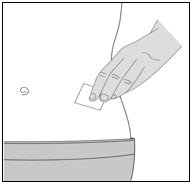
Use a different place each time you give an injection. Your care provider will show you where on your body to inject Lovenox. Do not inject this medicine into a muscle. You should be sitting or lying down during the injection. Do not use if the medicine has changed colors, or has particles in it. Prepare your injection only when you are ready to give it. Ask your doctor or pharmacist if you have questions. Do not use Lovenox if you don't understand all instructions for proper use. Read and carefully follow any Instructions for Use provided with your medicine.
#Lovenox antidote how to
A healthcare provider may teach you how to properly use the medication by yourself. Lovenox is injected under the skin, or as an infusion into a vein. Follow all directions on your prescription label and read all medication guides or instruction sheets. Lovenox is usually given every day until your bleeding condition improves. Lovenox pregnancy and breastfeeding warnings (more detail) How should I use Lovenox? It may not be safe to breast-feed while using this medicine. If you use Lovenox during pregnancy, make sure your doctor knows if you have a mechanical heart valve. Low blood platelets after receiving heparin. You are using a blood thinner ( warfarin, Coumadin) or other medicines to treat or prevent blood clots. You take aspirin or an NSAID (nonsteroidal anti-inflammatory drug) - ibuprofen (Advil, Motrin), naproxen (Aleve), diclofenac, indomethacin, meloxicam, and others or You have recently had a spinal tap or epidural anesthesia You have a history of spinal surgery or repeated spinal taps You have a spinal catheter in place or if a catheter has been recently removed This type of blood clot could cause long-term or permanent paralysis, and may be more likely to occur if: Lovenox can cause a very serious blood clot around your spinal cord if you undergo a spinal tap or receive spinal anesthesia (epidural). Stomach or intestinal bleeding or ulcer or Lovenox may cause you to bleed more easily, especially if you have:Ī bleeding disorder that is inherited or caused by disease Īn infection of the lining of your heart (also called bacterial endocarditis) If you had decreased platelets in your blood after testing positive for a certain antibody while using Lovenox within the past 100 days. You should not use Lovenox if you are allergic to enoxaparin, heparin, benzyl alcohol, or pork products, or if you have: Related/similar drugs amlodipine, lisinopril, aspirin, metoprolol, carvedilol, Eliquis, clopidogrel Before taking this medicine

Get emergency medical help if you have symptoms of a spinal cord blood clot such as back pain, numbness or muscle weakness in your lower body, or loss of bladder or bowel control. This type of blood clot can lead to long-term or permanent paralysis.



Lovenox can cause a very serious blood clot around your spinal cord if you undergo a spinal tap or receive spinal anesthesia (epidural), especially if you have a genetic spinal defect, a history of spinal surgery or repeated spinal taps, or if you are using other drugs that can affect blood clotting, including blood thinners or NSAIDs ( ibuprofen, Advil, Aleve, and others). You should not use Lovenox if you have active bleeding, or a low level of platelets in your blood after testing positive for a certain antibody while using enoxaparin. Lovenox is also used to prevent blood vessel complications in people with certain types of angina (chest pain) or heart attack. A DVT can occur after certain types of surgery, or in people who are bed-ridden due to a prolonged illness. Lovenox is used to treat or prevent a type of blood clot called deep vein thrombosis (DVT), which can lead to blood clots in the lungs (pulmonary embolism). Lovenox is an anticoagulant that helps prevent the formation of blood clots.


 0 kommentar(er)
0 kommentar(er)
